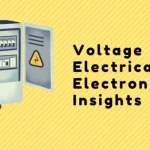DC Motor: Working Principle, Types, Losses, and Speed Control
A DC motor is an essential device that converts direct current (DC) electrical energy into mechanical motion. It plays a crucial role in various...
AC Motors & Induction Motor: Types, Working Principles, and Key FAQs
AC Motors are essential components in various applications, powering everything from household appliances to industrial machinery. This article explores the fundamentals of AC motors,...
Understanding Motor Nameplate Specifications: Voltage, Power, Current, and More
Motor nameplate specifications provide crucial information about a motor's performance, including its voltage, power, current, and operating conditions. Understanding these specifications is essential for...
Inverters, Star-Delta, and Soft Starters: Applications & Differences in Motor Control
Inverters, Star-Delta, and Soft Starters: In industrial applications, controlling motor speed is crucial for efficient operation and energy savings. Devices like inverters, star-delta starters,...
Understanding Electric Motor Ingress Protection (IP) Rating
Electric Motor IP Rating / Ingress Protection (IP) Rating: It is often observed that various electrical equipment comes with an IP(Ingress Protection) rating or...
How to Connect a Motor Using Delta (Δ) Connection
The delta connection is a fundamental wiring method used in three-phase electrical systems, particularly for connecting motors. In this configuration, the windings of the...
Synchronous Motor: Definition, Components, and Working Principles
Synchronous motors play a critical role in various industrial and mechanical applications. Unlike other motors, they operate at a constant speed from no load...



